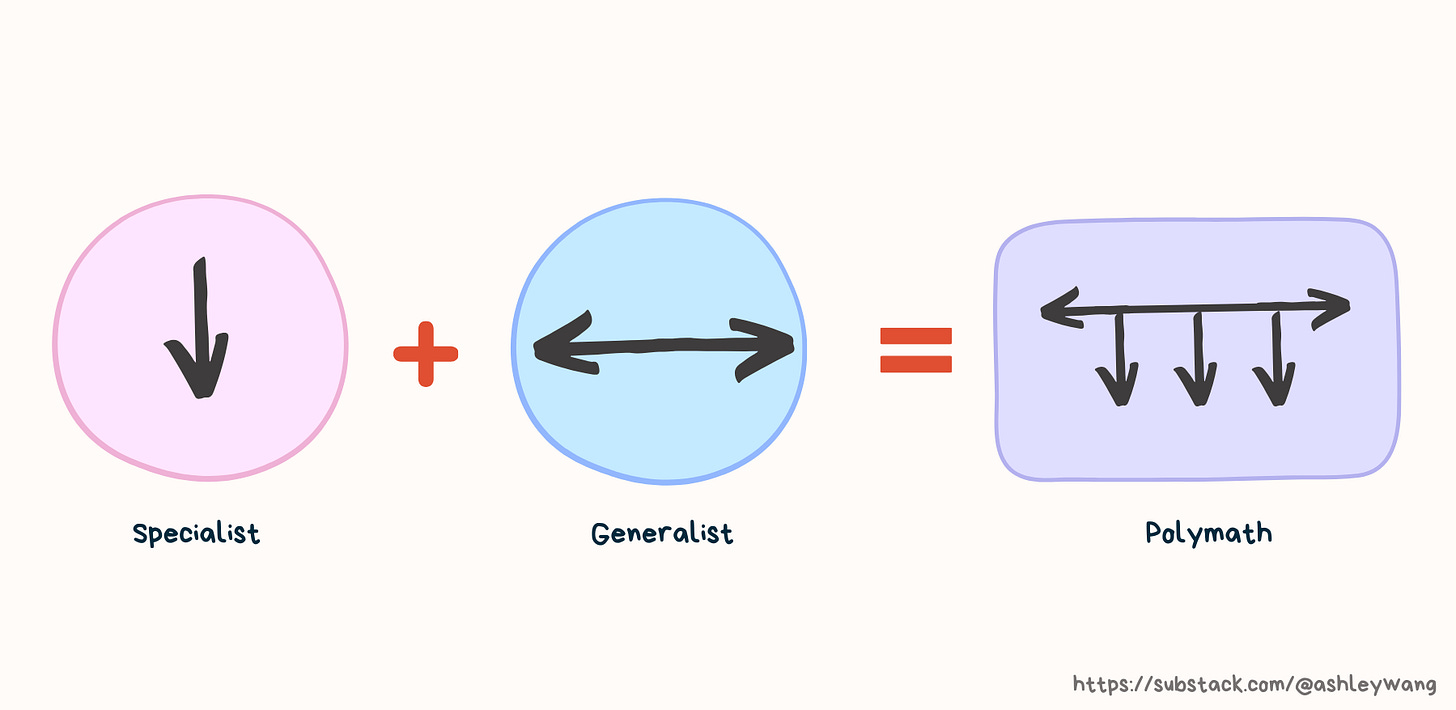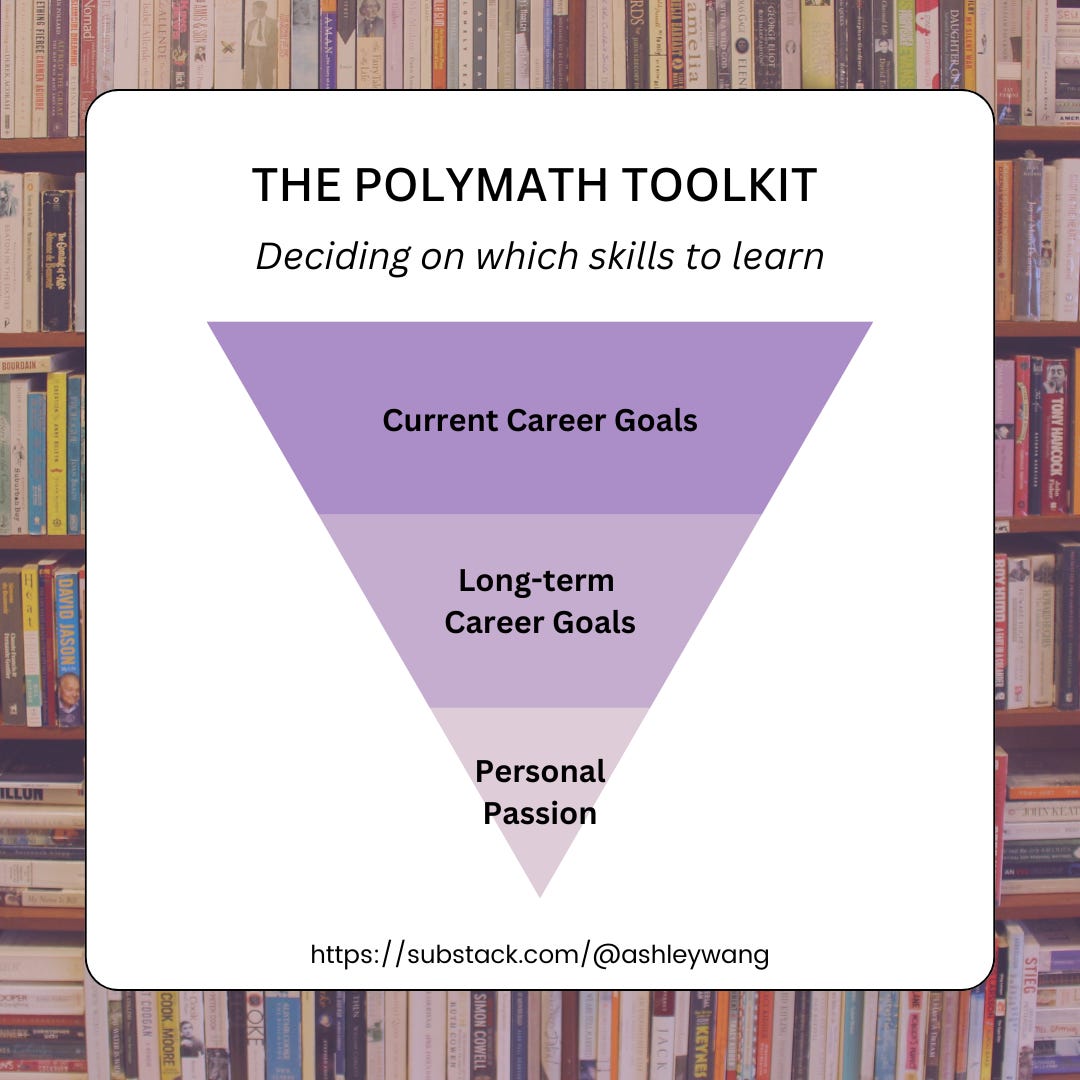Master of Many: How Becoming a Polymath Elevates Customer Success
Harnessing expertise across domains (and lessons from a stubborn Shiba Inu) to navigate challenges
Here’s a question that haunted me for years growing up:
"What are you passionate about?"
I envied people who seemed to have it all figured out - those who discovered their passion early on and pursued it with laser focus.
Take my childhood friend, Jeff, for instance. He was obsessed with whales and sharks as a kid. And that passion never faded. He landed a scholarship to Yale and now he’s living his dream as a research scientist in ocean ecology.
Meanwhile, there I was, floundering in a sea of interests, struggling to find that one true calling.
It took me years to realize that my passion is learning through diverse interests.
In this post, I’ll dive into the definition and the superpower of polymaths, and why becoming one can be a game-changer for Customer Success Managers.
Polymath in Customer Success
What is a polymath?
Most of us have heard of a specialist and a generalist. A polymath is the sweet spot in between:
Specialist: Master of one
Generalist: Jacks-of-all-trades, master of none
Polymath: Have expertise in three or more domains
Leonardo da Vinci is a famous polymath. Not only was he a talented painter, he was also an engineer, sculptor, scientist, and inventor.
Sharing some wisdom from da Vinci:
Study the science of art. Study the art of science. Develop your senses - especially learn how to see. Realize that everything connects to everything else.
(For a deep dive into polymathism, I’ve linked in the Resources section a fascinating talk by the Head of Product Development at Amazon, Penny Szeto.)
Why Customer Success Managers should be polymaths?
Early in my Customer Success career, I hit a wall. The business owners in my portfolio were power users of a complex product I had just started working with. The product is incredibly versatile, but the more intricate a system is, the steeper the learning curve. And these seasoned users surely knew the ins and outs better than I did, leaving me feeling like there wasn’t much I could do to enrich their experience.
As I familiarized myself with the product, I continued to seek ways to optimize their configurations, hoping to add value. However, I soon faced another hurdle: the Implementation Team had already fine-tuned many accounts. This left me puzzled: how could I make a meaningful impact beyond what had already been accomplished?
Like many complex challenges, there was no one-size-fits-all solution. I knew I needed to venture beyond the product and arm myself with more skills.
Becoming a Polymath
Building Your Polymath Toolkit
A polymath has expertise in multiple domains. So, how do you choose and curate the right mix of skills to make the most impact?
Here’s my simple three-step approach:
What skills would make you more effective right now? Begin by identifying areas most relevant to your current role.
What skills would benefit you in the long run? Consider your long-term career goals and choose skills that will help you get there.
What skills interest you? Find topics that genuinely spark your curiosity - staying motivated is key to learning!
As you explore, you’ll gain a deeper understanding of your role, your industry, and yourself. Hence why, throughout this fluid process, you may find yourself moving up and down the funnel.
The more you learn, the more you realize how much there is to learn. It’s about connecting the dots in unexpected ways. -Robert Greene
Take my journey as an example:
I came from a background in financial services and business analytics. When I stepped into the SaaS world, my technical toolkit was limited to SQL and data analysis. As for my long-term career goal? It’s Product Management.
Naturally, I dove headfirst into learning APIs, HTML, and Python. But here’s the catch - I found these topics so dry that learning became a chore. Plus, with the rise of AI, I didn’t feel the need to become a coding wizard to grasp fundamentals. So, after gaining a few basic concepts, I decided to shift gears.
I went back to the drawing board and laid out the domains that could help in my current role, keeping in mind that our product is B2B2C in the travel industry:
Business Foundations | Marketing, Financial Analysis, Operations Management
Design | Consumer Psychology, UX/UI, Information Architecture
Tech | API Integration, Python, Software Architect
Data | Business Intelligence, Data Visualization, Machine Learning, GA4
Industry Expertise | Travel Trends, Online Travel Agencies, Reservation Tech
Creative Writing | Engaging Outbound Emails, Product Updates
With my product management aspirations as my North Star, I cherry-picked a few topics from these domains. One of them was design. Specifically, website optimization and consumer psychology. I find these topics fascinating. Unlike programming, the deeper I delve into them, the more intrigued I become.
Putting Polymath Toolkit to Work
Studying alone won’t do the trick. Real learning comes from doing - through trial, error, and continuous improvement.
You don’t have to be great to start, but you have to start to be great.
Many of my accounts have websites, giving me the perfect playground to test my budding design skills. Initially, my website optimization tips didn’t seem to land. However, each attempt taught me what wasn’t working:
Lengthy emails morphed into bullet-pointed slide decks
Screenshots evolved into Figma wireframes
Simple advice on colour contrast ratio grew into comprehensive suggestions about homepage layouts and content
Then came a breakthrough. A business who had been struggling with declining revenue asked for help optimizing our product configuration to boost sales.
With my newfound understanding of UX principles, I spotted a bigger issue - their painfully outdated, user-unfriendly website.
Rather than focusing only on configuration tweaks, I provided recommendations for improving their navigation flow and user engagement. The goal was to reduce drop-offs and increase conversions.
The client was pleasantly surprised by the shift in focus. So much so, they admitted they had been considering churning, but ultimately chose to renew because of the unexpected insights we brought to the table.
By learning as you go and drawing from diverse skills, you’ll start approaching challenges from multiple angles, spotting connections and opportunities that weren’t visible before.
Beyond Technical Skills: The Power of Hobbies
Being a polymath doesn’t mean limiting yourself to just technical domains. You can also find connections and patterns in your hobbies.
Here are how some of my hobbies have contributed valuable insights:
Chess: Strategic thinking and anticipating customer needs
Travel: Adapt and navigate new environments, embrace diverse perspectives
Reading: Broaden empathy and storytelling abilities
Dog Training: Patience and positive reinforcement in nurturing relationships
I have the most stubborn Shiba Inu on the planet…
Polymath Skills in Action
A Real-Life Example
I once onboarded a business owner who ran his operation solely on spreadsheets. The sheer volume of data in Excel was staggering. He wanted to digitize his business, but the transition was daunting and challenging - he had to abandon his entire workflow and adopt a new one.
Here’s where having a range of skills made a difference:
Financial Services: When I introduced mutual funds to newbie investors, I often relied on gradual adoption - start small. That’s exactly what I did here. We had a secure Partner Account feature that he was afraid to utilize. So we started small - I suggested just setting up one partner account to test the waters. Within two months, he was fully comfortable and created over 20 partner accounts, slashing his admin time by 35%.
Scrum Methodology: There was a laundry list of goals and problems he wanted to tackle. With a biweekly check-in cadence, we prioritized the wish list using MoSCoW and reshuffled it as new insights surfaced. Staying nimble kept us on track without veering off into the weeds.
UX/UI: One of his main goals was to increase revenue. I conducted a thorough website audit and highlighted areas for improvement. Simple tweaks, like changing the verbiage on CTA buttons and adding testimonials for social proof, made a noticeable impact on his conversion rates.
Dog Training: If my Shiba taught me anything, it’s that patience and positive reinforcement go a long way. I brought the same mindset here - celebrating small wins as he embraced new workflows, which motivated him to keep going.
From my experience, blending diverse skills enables you deliver solutions that exceed expectations. By drawing connections between seemingly unrelated domains, you bring unique insights and added value. So, keep learning and embrace your interests - they’re your secret weapons for supercharging your career!
Wrapping Up
What unexpected skills or interests have enhanced your Customer Success career What’s the most unconventional skill you’ve found useful in your Customer Success role?
Share in the comments below - I’d love to hear your stories!
Resources
Polymathic Product Manager Talk by Head of Product Development at Amazon, Penny Szeto
Coursera Introduction to Marketing | Free if completed within the 7-day free trial period - it’s very doable!
Scrimba | Free programming and web development courses
HubSpot Website Optimization Course | Free course
Growth Design | Product psychology courses and free resources
Design Better | Tech design blog
Codecademy Learn Basic SQL | Free course
Skillshop | Free courses for Google tools (GA4, Google Ads, etc)
Untools | Problem-solving, decision-making tools





